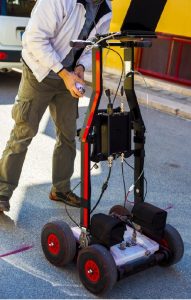Ground-penetrating radar is a useful technology for helping people uncover underground utilities on construction sites. It’s vital to the safety of everyone working on a construction site. But how exactly does this technology work? Find out everything you need to know about ground-penetrating radar.
The Basics of Ground Penetrating Radar
Ground-penetrating radar, also known as GPR, is a technology that significantly raises the safety of a construction site. It makes use of high-frequency radio signals, sending them into the ground. Once these signals are sent underground, they reflect off of obstructions that are found beneath the surface. After that, a computer is used to measure how long it took for the waves to come back to the surface. This determines the depth of underground obstructions.
Ground Penetrating Radar Data Collection (Below Ground)
In order for people to find underground obstructions, as well as how deep those obstructions are, there are many types of GPR equipment that have to be used while collecting data. Workers have to pick certain GPR equipment depending on how large an object is and how deeply the object is buried underground.
The radar unit sends out and receives signals that have been reflected against underground obstructions. This happens as often as one thousand times per second. A field operator then analyzes the signals, and the signals also get stored in a computer where they can be further analyzed if necessary.
Ground Penetrating Radar Data Collection (In Concrete)
To find objects like rebar, workers have to use post-tension cables and conduits that are infused into GPR systems. The thickness of concrete can be analyzed, and there can even be a map that detects objects found underneath the concrete. By doing this, 3D maps of the subsurface can be created, and workers can find the exact depth of underground objects.
GPR Data Analysis
GPR waves can traverse through a variety of materials. However, soil, concrete, and debris are among the materials that can impact GPR waves, which complicates data interpretation. While data images can be viewed by anyone who sees the images, it requires an expert to truly interpret them so that the findings can be interpreted accurately.
Concrete Visions Will Get The Job Done Right
Concrete Visions has been working with clients for over 25 years. Our G&M Services installers are certified with the industry’s major firestop product manufacturers. As part of our firestop service, we can assess abnormal field conditions and, with the manufacturer’s technical support assistance, provide engineering judgments in a timely fashion to comply with contract specifications. Our Field Mechanics undergo ongoing training, including mandatory monthly safety meetings, weekly Toolbox Talks where safety and equipment information is shred, and trainings on safe work standards and safety best practices.

